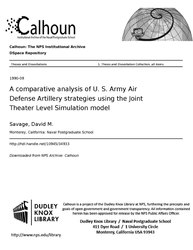File:A comparative analysis of U. S. Army Air Defense Artillery strategies using the Joint Theater Level Simulation model (IA acomparativenaly1094534933).pdf

Original file (1,275 × 1,650 pixels, file size: 2.84 MB, MIME type: application/pdf, 68 pages)
Captions
Captions
Summary[edit]
| A comparative analysis of U. S. Army Air Defense Artillery strategies using the Joint Theater Level Simulation model
( |
||
|---|---|---|
| Author |
Savage, David M. |
|
| Title |
A comparative analysis of U. S. Army Air Defense Artillery strategies using the Joint Theater Level Simulation model |
|
| Publisher |
Monterey, California: Naval Postgraduate School |
|
| Description |
This thesis seeks to determine if US Army Defense Artillery (ADA) units positioned in a belt defense perform better than the point defense that the US Army currently uses. It does this through a comparison of three ADA defense strategies: (1) Forward Concentration (belt defense); (2) Balanced Concentration (point defense); and (3) Rear Area Concentration (point defense). The Joint Theater Level Simulation, a computer combat simulation model, is used as a tool for analysis to compare the three strategies in a Fulda Gap scenario against a variety of Soviet attack options. The JTLS model is used because of its ability to simulate large forces and also to demonstrate the value of JTLS as an analytical tool, in addition to a training and evaluation tool. Using the following measures of effectiveness: Soviet airplanes shot down by US ADA, percentage of successful Soviet bombing missions, and number of US ground- targets destroyed, the forward concentration defense proves to have a significant advantage over the other two strategies, regardless of the weighting of the measures of effectiveness. Subjects: Operations research; Strategy.; JTLS; ADA strategy; point defense; belt defense |
|
| Language | English | |
| Publication date |
September 1990 publication_date QS:P577,+1990-09-00T00:00:00Z/10 |
|
| Current location |
IA Collections: navalpostgraduateschoollibrary; fedlink |
|
| Accession number |
acomparativenaly1094534933 |
|
| Source | ||
| Permission (Reusing this file) |
This publication is a work of the U.S. Government as defined in Title 17, United States Code, Section 101. As such, it is in the public domain, and under the provisions of Title 17, United States Code, Section 105, may not be copyrighted. | |
Licensing[edit]
| Public domainPublic domainfalsefalse |
This work is in the public domain in the United States because it is a work prepared by an officer or employee of the United States Government as part of that person’s official duties under the terms of Title 17, Chapter 1, Section 105 of the US Code.
Note: This only applies to original works of the Federal Government and not to the work of any individual U.S. state, territory, commonwealth, county, municipality, or any other subdivision. This template also does not apply to postage stamp designs published by the United States Postal Service since 1978. (See § 313.6(C)(1) of Compendium of U.S. Copyright Office Practices). It also does not apply to certain US coins; see The US Mint Terms of Use.
|
 | |
| This file has been identified as being free of known restrictions under copyright law, including all related and neighboring rights. | ||
https://creativecommons.org/publicdomain/mark/1.0/PDMCreative Commons Public Domain Mark 1.0falsefalse
File history
Click on a date/time to view the file as it appeared at that time.
| Date/Time | Thumbnail | Dimensions | User | Comment | |
|---|---|---|---|---|---|
| current | 06:47, 8 July 2020 |  | 1,275 × 1,650, 68 pages (2.84 MB) | Fæ (talk | contribs) | FEDLINK - United States Federal Collection acomparativenaly1094534933 (User talk:Fæ/IA books#Fork8) (batch 1990-1992 #2798) |
You cannot overwrite this file.
File usage on Commons
The following page uses this file:
Metadata
This file contains additional information such as Exif metadata which may have been added by the digital camera, scanner, or software program used to create or digitize it. If the file has been modified from its original state, some details such as the timestamp may not fully reflect those of the original file. The timestamp is only as accurate as the clock in the camera, and it may be completely wrong.
| Short title | A comparative analysis of U. S. Army Air Defense Artillery strategies using the Joint Theater Level Simulation model |
|---|---|
| Author | Savage, David M. |
| File change date and time | 06:18, 10 January 2012 |
| Date and time of digitizing | 06:18, 10 January 2012 |
| Date metadata was last modified | 06:18, 10 January 2012 |
| Software used | Savage, David M. |
| Conversion program | |
| Encrypted | no |
| Page size |
|
| Version of PDF format | 1.4 |

